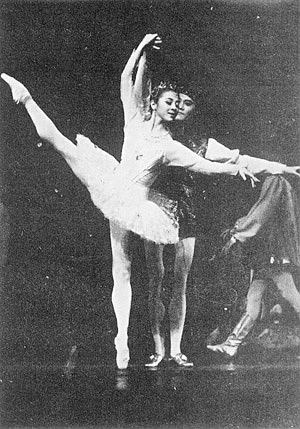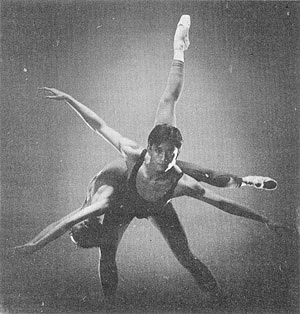|
 |
|
A pas de deux during Central Ballet of China's production of Sleeping Beauty (YU LIE) |
China's acclaimed Central Ballet Co. (later change to name National Ballet of China) is hoping to take American audiences by storm later this year when it undertakes a three-month tour boasting an exciting repertoire that takes in traditional classical works such as Giselle and Don Qixote, as well as its renowned revolutionary piece The Red Detachment of Women.
However, the company's recent outing in Beijing with Tchaikovsky's romantic masterpiece Sleeping Beauty picked up mixed reviews despite the assistance of respected British choreographer Monica Parker. There is a consensus in the company - amongst both performers and administrators - that the production lacked the high level of artistic quality demanded of an international troupe and certainly did not reflect its proud 36 year history.
Ironically, when a leading Russian ballet company first produced French choreographer Marius Petipa's stage interpretation of Sleeping Beauty 100 years ago it was considered to be a turning point in dance history because it supposedly put an end to slackness in performance.
Yet, despite the self-criticism capacity audiences at Beijing's Poly Plaza theater applauded, often wildly, the intricate and complex movements of Central Ballet's principal dancers in what is considered to be one of the most difficult classical dramatic ballets in the world. And the company's earlier sequence of contemporary dance routines was stylishly handled and widely enjoyed by the participants and audience alike, particularly a new work put to Bach's piano concerto Op 1056 choreographed by Parker's young assistant William Tuckett.
The newly appointed, tough-talking artistic director Zhao Ruheng, herself a former principal dancer who has been involved with the company since its inception, pulls no punches when she reflects on the problems although she does concede that there is considerable flair amongst the principals. "But there are essential difficulties in the corps de ballet, and its teamwork needs to be tightened up," she complains, adding that she thought, too, the orchestra was not fully up to scratch on this occasion.
At recent rehearsals for its next production of the tragic classic tale Giselle, planned to be staged in Beijing early July along with the Bach ballet, Zhao pushed the team to its limits and then, as they slumped on the floor exhausted after a punishing hour long stretch, launched into a critical monologue accusing them of looking "tired". Perhaps there was some justification for the troupe's weariness as the dancers endure almost daily a rigorous regime of more than five hours of gruelling practice and exercise sessions. But Zhao declares that she is not simply scolding for its own sake. "We have to get it right, and our performance needs to be perfect if we are to win new audiences and, more importantly, sponsors," she explains.
 |
|
The Central Ballet is increasingly adding dazzling contemporary dance routines to its repertoire |
This, in fact, is the essence of her publicity drive to promote the company. There has been much coverage in the Chinese media about the Central Ballet's dire financial straits which are such that there is only enough funding left for two more productions in China this year and a question mark generally hangs over 1996. Sleeping Beauty was made possible by the support of the Changjiang Enterprise Co. and the China Performing Arts Agency, which is under the control of the Ministry of Culture, while the U.S. tour is being paid for by the Columbia Artists Management organization in New York.
Zhao, softening a little, admits that the financial restraints can be very discouraging for the 330-strong company which she agrees with mostly makes strenuous efforts and works very hard and long hours.
"It is true we are government funded and, all our housing, insurance, medical cover and repairs to the building are paid for. We have no worries about that," she said. "But there is very little left to actually stage many works or rent theaters, and this has a very negative effect on the dancers. We are desperate to attract new benefactors, both in China and abroad, who will sponsor productions."
She explains that, like most dance companies worldwide, guest choreographers and designers are invited to work with the company, but the cost is prohibitive. It was a coup for the Central Ballet to secure the services of Monica Parker who was the personal assistant to the legendary British choreographer Sir Kenneth MacMillan for 25 years, initially with the Deutsche Opera in Berlin and later with the esteemed Covent Garden Royal Ballet in London where she is still based. Several Chinese based organizations covered the expenses and accommodation for her and Tuckett.
Parker is more inclined to benevolence about Central Ballet's efforts than Zhao - they have been friends for 15 years ever since they met at a dancing camp in Hong Kong - and even enthuses that the leading dancers could easily be counted amongst the best in the world. She returns to Beijing in August, after a stint with Australian Ballet, to prepare the troupe for the U.S. tour which kicks off in September.
Her cooperation with Central Ballet began last summer when she arrived to direct and coach its dancers for Sir Kenneth MacMillan's famous Concerto work. That was such a successful partnership that she pleaded to be allowed to help with Sleeping Beauty, which has long been considered one of the cornerstone's of any ballet company's repertoire. Parker explains, "It makes enormous demands upon the dancers and demonstrates their artistic qualities."
Whilst holding the principals in high regard she tends to agree with Zhao Ruheng that the corps de ballet still exhibits problems.
"They have had little stage experience and are nearly all under 30. They need more opportunities and challenges," she exclaims, echoing Zhao's own confirmation that the troupe can excel once it has been given the chance.
Indeed, in the company's defense its actual theater rehearsal time for Sleeping Beauty was crucially short; two days to bring everything together, the lighting, music and sets, as well as time for the dancers to assimilate the mood of the auditorium.
"We could not pay for any more time and were forced to rehearse until almost midnight which was exhausting for the dancers," Zhao pointed out.
Founded in 1959, the Central Ballet has a wide classical repertoire which includes Swan Lake, Romeo and Juliet, Giselle and Le Corsaire. But Sleeping Beauty is by far the largest scale ballet it has ever staged. It involves more than 100 dancers and costs about 3 million yuan to perform; most of the money being used on sets, lighting and 270 lavish costumes.
The company has been transformed into a world recognized dancing force thanks to the creative genius of some of its earlier doyens such as musician Zhao Feng, dancer Dai Ailian, conductor Li Guoquan and subsequent generations of artistes and technicians all devoted to achieving perfection.
Since the early 1960s it has performed in 18 of China's provinces and more than 30 cities and has toured Asia, Europe, North America and Africa. In 1986 it enjoyed triumphant seasons in America, Britain and Russia followed by equally successful tours of Germany, Holland, Switzerland, Belgium and Austria which won the dancers international prestige.
Unlike its foreign counterparts, though, the Central Ballet is able to combine the traditional Western style ballets with the Chinese idiom such as the full length The Red Detachment of Women, a still hugely popular revolutionary work which was the company's linchpin during the turbulent "cultural revolution" (1966-1976), with Lin Daiyu, The Maid of the Sea and The New Year Sacrifice all audience pullers wherever they are performed.
Today, its fifth generation dancers - including the eight principals - are all graduates of the Beijing Dance Academy, and a number of world-class standing have emerged with several winning international awards, in Moscow and the United States. | 